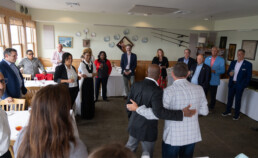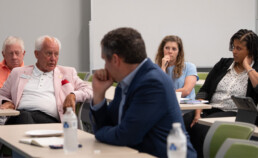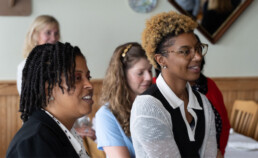Dare County June 2023
Population
37,956
County Seat
Manteo
Median Income
$69,500
Population Density Designation
Rural
Dare County is at the heart of one of North Carolina’s premier tourist destinations: the Outer Banks. The community leaders, educators and health care workers who welcomed the Extra Miles Tour to Manteo acknowledged that their county is lucky. They also emphasized that being home to lucrative tourist and fishing industries doesn’t mean Dare hasn’t faced significant challenges. Time and again, the county has risen to these challenges by drawing strength from collaboration. Fittingly, our visit to Dare County started at the College of the Albemarle, a regional community college with four different campuses serving seven counties. The setting embodied a sentiment heard many times over the course of our visit: Strengthening the communities in such a rugged, remote region requires everyone to work together, to break down silos, to find compromise and to stay focused on shared goals.
The discussions at the college revolved around two themes: Community health and workforce development. Representatives from the Saving Lives Taskforce kicked off dialogue around community health by outlining their aggressive approach to combatting overdose deaths in the county. In 2021, there were 17 lives lost to overdoses – 14 caused by fentanyl. As the team made clear, substance use disorders hit everyone, regardless of class, education or upbringing. In response, the Taskforce is widely distributing free packets that include Naloxone (the drug that can reverse opioid overdose) and information for recovery support. Their goal is to make these lifesaving materials more “present” in the community: Not behind counters, not stored in desks, but visible and easily retrievable at every school, every restaurant, every public space and in homes. The presentation did emphasize the importance of making any strategy adaptable, as evidenced by the fact that horse tranquilizers are now commonly found in 40% of tested drugs; these can lead to necrosis of tissue, and Naloxone does not neutralize them.
Later in the day, the Blue Cross NC team was treated to a demonstration of the campus’s Dare to C.A.R.E. program. Initially developed by the Heart Health Foundation, this cutting-edge program uses handheld ultrasound technology to evaluate cardiovascular health and provide individuals with analysis and medical advice on the spot. Letting someone see the plaque buildup in their arteries and putting them in immediate contact with professional care increases the odds that a visit to Dare to C.A.R.E. will mark a turning point toward prevention. The College of the Albemarle pooled resources with The Rotary Clubs of the Outer Banks to launch this program in Dare County just six months ago. Its impact is already impressive: 200 area residents have been screened. So far, the disease detection rate has exceeded the national average, and most of those identified as at risk are not yet on simple medications that could reduce their chances of experiencing a dangerous cardiovascular event.
Discussions around workforce development explained how some of the college’s signature programs put students on track toward well-paying and rewarding careers while also supporting the key industries in the region. The campus’s new “professional arts” building houses programs teaching welding, electrician and HVAC training, as well as “heritage arts” such as jewelry and pottery. The Blue Cross NC team toured the welding lab, which helps build the workforce needed to keep the regional ferry division afloat (and currently counts a grandfather and his granddaughter among its current crop of students). The unusual HVAC and electrical lab featured a life-size frame of a house, built with supplies and labor donated by the community. The setup gives students an opportunity to get hands-on training and a realistic space for practicing wiring and evaluating building codes. In addition to feeding talent into the area’s all-important housing industry, these programs also support local restaurants and the fishing industries, which both rely on refrigeration.
That evening, the community seafood dinner was hosted by Basnight’s Lone Cedar Café, a local landmark. As guests mingled, some were lucky enough to hear ornithologist and College of the Albemarle President Jack Bagwell share his knowledge of the area’s birds, including the giant osprey roosting just outside the restaurant’s picture window overlooking Roanoke Sound. Before dinner, representatives from across the community shared insights into what makes the area so vibrant. Discussion focused on the intentional work to avoid “loving the Outer Banks to death,” and the importance of the collaborative spirit that has guided the area’s successes supporting tourism (including securing funds for beach renourishment and dredging to keep the sound navigable), strengthening local schools and responding to COVID-19 and other health crises.
If there was a recurring theme to a stop with such a diverse array of activities and presentations, it was articulated by Dr. Bagwell earlier in the day: “When you lean in as a community, you can get things done.”
All other trade names are the property of their respective owners. U39702, 7/23





